Probing Egypt's Pyramids and Tombs with Modern Scanning Technology
An exploration of how cutting-edge physics and engineering are revealing ancient secrets
By Jim Walker, September 2025
Introduction

For more than four millennia, Egypt's monumental pyramids and tombs have guarded their secrets, frustrating generations of archaeologists. Today, however, scientists are deploying advanced non-invasive scanning techniques – from cosmic-ray muon detectors to ground-penetrating radar – to peer inside these structures without a single stone removed. These methods are enabling discoveries of hidden voids and resolving long-standing mysteries about the construction and contents of ancient royal monuments.
In this article, I review recent scientific investigations at two iconic sites: the Great Pyramid of Khufu on the Giza Plateau and the Tomb of Tutankhamun (KV62) in the Valley of the Kings. The discussion explores how modern imaging revealed a previously unknown “void” inside Khufu’s Pyramid, and how multiple advanced surveys searched for—but ultimately did not confirm—the existence of hidden chambers in Tutankhamun’s tomb. It also explains the physics behind muon radiography and radar sensing, and considers the significance of these findings for Egyptology.
Note: Synthesized ambience for context; user‑initiated only.
The ScanPyramids Project and the Great Pyramid of Khufu
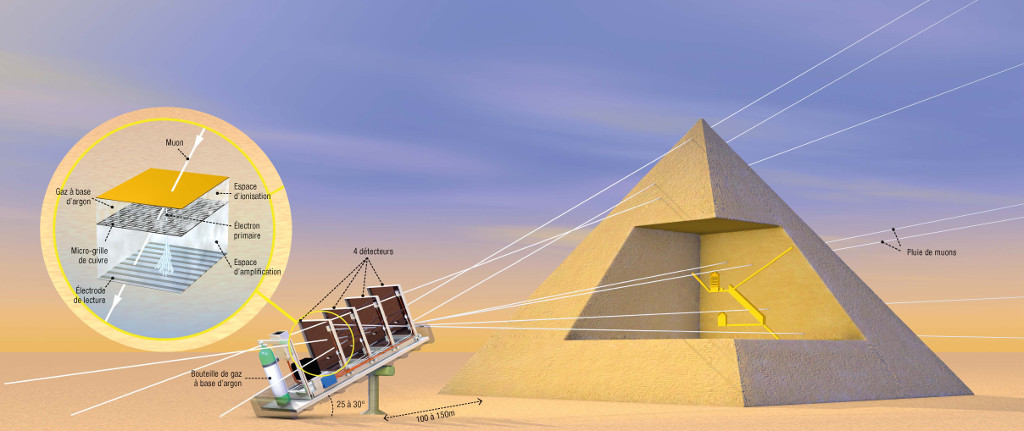
One of the most ambitious efforts to explore Egypt's pyramids non-destructively is the international ScanPyramids mission, launched in 2015 by Egypt's Ministry of Antiquities in collaboration with the HIP Institute (France) and Cairo University. The project focuses on Old Kingdom pyramids – including the Great Pyramid of Khufu (also known as Cheops), Khafre's Pyramid at Giza, and the Bent Pyramid and Red Pyramid at Dahshur, with the goal of detecting any unknown internal voids or structures.
ScanPyramids employs a suite of cutting-edge, non-invasive technologies: infrared thermography to spot temperature anomalies on pyramid surfaces, muon tomography to image interior density differences, and 3D modeling for visualization. These methods complement traditional archaeological approaches and can "X-ray" massive stone edifices that are impenetrable to regular X-rays or endoscopic cameras.


Early results from ScanPyramids were promising. In late 2015, thermal infrared scans detected an unusual temperature excess on the north face of Khufu's Pyramid, just above the ancient entrance – hinting at a possible hidden structure behind the stones. To investigate, the team deployed muon detectors inside known passageways of the pyramid.
The Discovery of the "Big Void"
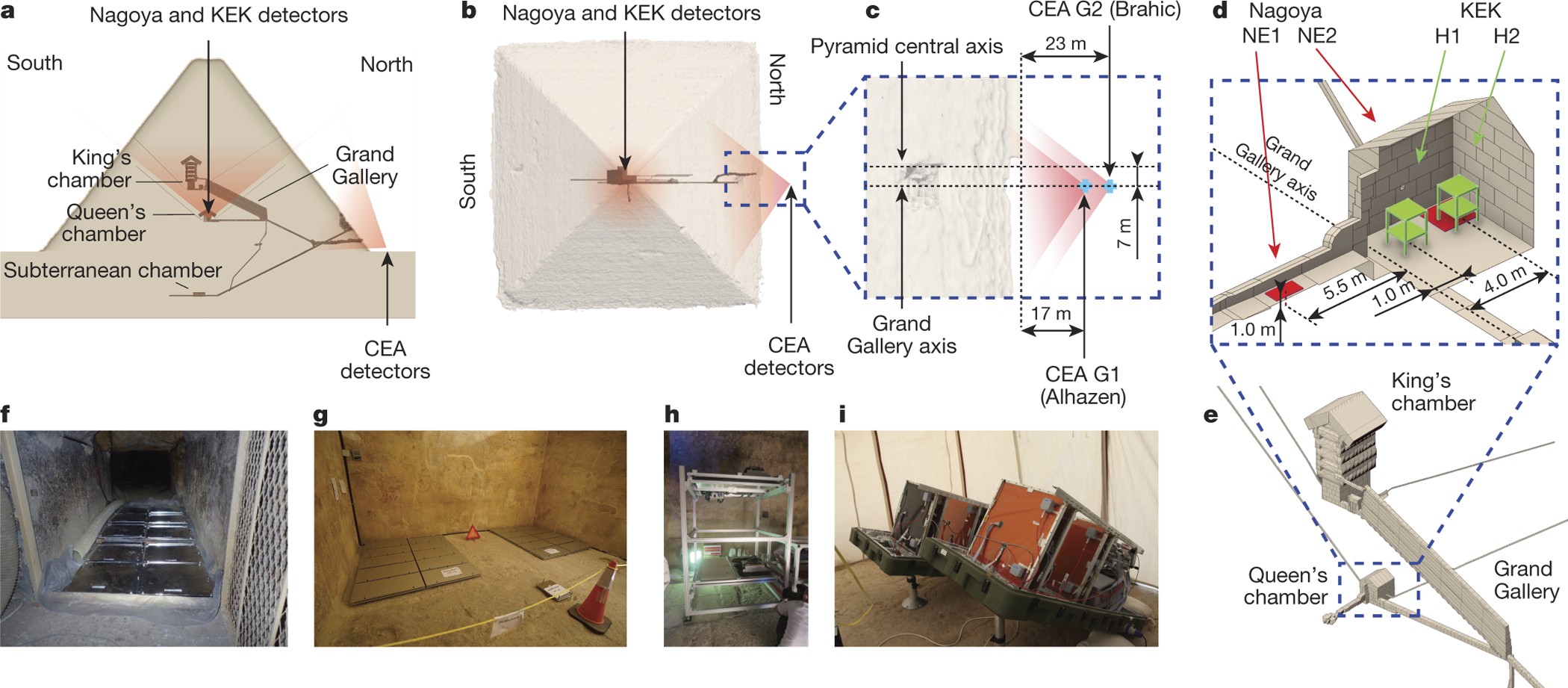
In 2017, ScanPyramids made international headlines with a dramatic finding. Using upgraded muon detectors from three independent teams (Nagoya University, KEK in Japan, and CEA in France) and viewing from multiple angles, the researchers detected a giant void deep within the Great Pyramid. This void, announced in Nature in November 2017, was nicknamed the "ScanPyramids Big Void" due to its enormous size.
It is positioned above the Grand Gallery in the pyramid's central core, roughly 40–50 m into the structure from the north face. The Big Void is at least 30 m long – comparable in length to the Grand Gallery itself – with a cross-section similar to that huge sloping corridor (about 8 m tall). Its exact shape is not yet known; it could be one large chamber or a series of smaller chambers adjacent to each other, oriented either horizontally or on an incline.
The Hidden North Face Corridor
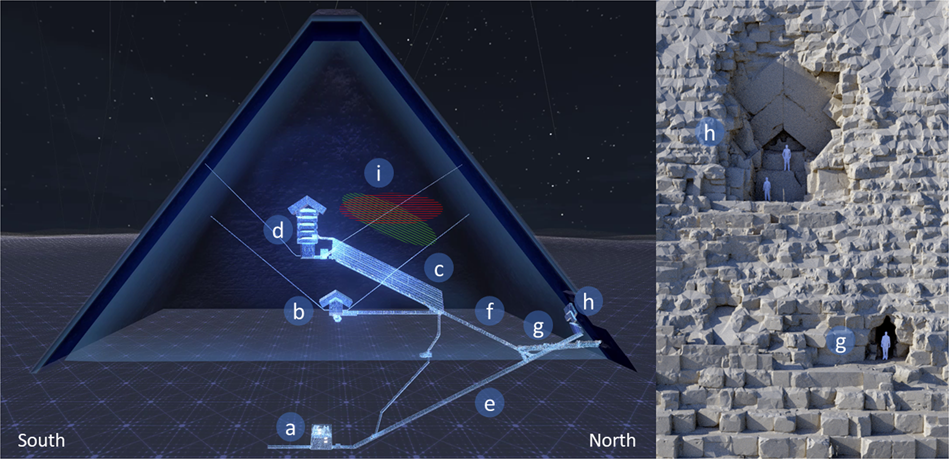
After the Big Void announcement, the ScanPyramids team continued to investigate the earlier north face anomaly with a combination of muography, ground-penetrating radar (GPR), and ultrasonic testing. By collecting more muon data up to 2019, they were able to precisely map the "North Face Corridor" void's dimensions: about 9 m long (along its north-south axis) with a cross-section roughly 2 m × 2 m.
Finally, in February 2023, the team gained direct access by drilling a small (~2 cm) hole through a joint in the chevron blocks and inserting an endoscopic camera. The camera captured the first images ever seen of this hidden corridor:
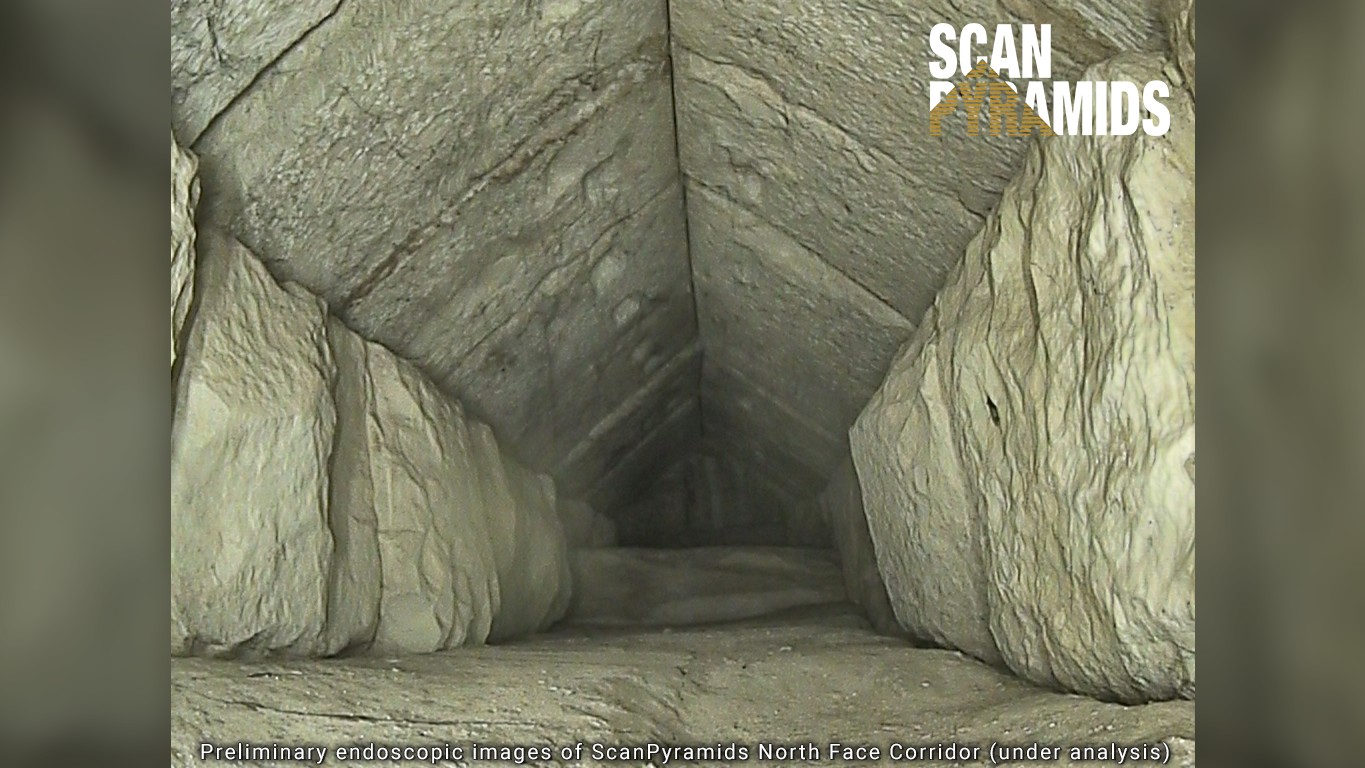
The space appears empty and does not connect to any further chambers – its plastered end walls indicate it's a distinct, closed corridor. It lies roughly 7 m behind the present tourist entrance (which is the medieval tunnel) and directly above the original Descending Passage entrance.
Scanning Methodologies: Muon Tomography and GPR in Archaeology
Muon Tomography: Cosmic Rays as Archaeological Tools


The discoveries in Khufu's Pyramid were made possible by muon tomography, a technique first proposed by physicist Luis W. Alvarez in the 1960s to search for hidden chambers in pyramids. Muons are unstable subatomic particles, similar to electrons but over 200 times heavier, that are created when cosmic rays strike Earth's upper atmosphere. They rain down ubiquitously and can penetrate significant thicknesses of rock before decaying.
Note: Muon imaging is silent; this is a representational cue.
In muon radiography, sensitive detectors (such as nuclear emulsion films or scintillators) are placed in or around the structure of interest to record incoming muons over long exposure times. If a detector "sees" more muons coming through a particular direction than expected, it means those muons encountered less dense material along their path – in other words, a void or empty space allowed more muons to pass than solid stone would.
Now on to Ground-Penetrating Radar in Archaeological Investigations

Another indispensable scanning tool is ground-penetrating radar (GPR). GPR uses high-frequency radio waves broadcast into walls or ground; the signals bounce back when they encounter interfaces between materials of different dielectric properties (for example, an interface between solid stone and an air-filled void). By moving antennae across a surface, technicians can detect reflections that indicate hidden cavities or structures up to several meters beyond the surface.
GPR has been widely used in archaeology to search for tombs, tunnels, and other sub-surface features without excavation. Its application in Egypt came to global attention with the controversy over Tutankhamun's tomb. Typically, multiple radar frequencies are used: higher frequencies (~1000 MHz) give sharper resolution but shallow penetration, whereas lower frequencies (~400 MHz or 200 MHz) penetrate deeper (several meters) at the cost of detail.
The Search for Hidden Chambers in Tutankhamun's Tomb
Perhaps the most publicized archaeological scan of recent times has been the investigation of Tutankhamun's tomb (KV62) in the Valley of the Kings for hidden chambers. Tutankhamun's tomb was discovered by Howard Carter in 1922 and is famed for its treasure, but it has a puzzling layout. Unlike the typically large pharaonic tombs with multiple corridors and chambers, KV62 is tiny – essentially an entry passage and four rooms arranged in a bent-axis plan.
In 2015, Egyptologist Nicholas Reeves put forward a bold hypothesis: high-resolution 3D scans of the tomb's walls suggested the presence of two large sealed doorways, one in the north wall of the burial chamber and one in the west wall. According to Reeves, the north wall of the burial chamber might hide a doorway leading to an extension of the tomb, potentially the undisturbed burial chamber of Queen Nefertiti.
The Radar Controversy: Multiple Scans, Conflicting Results
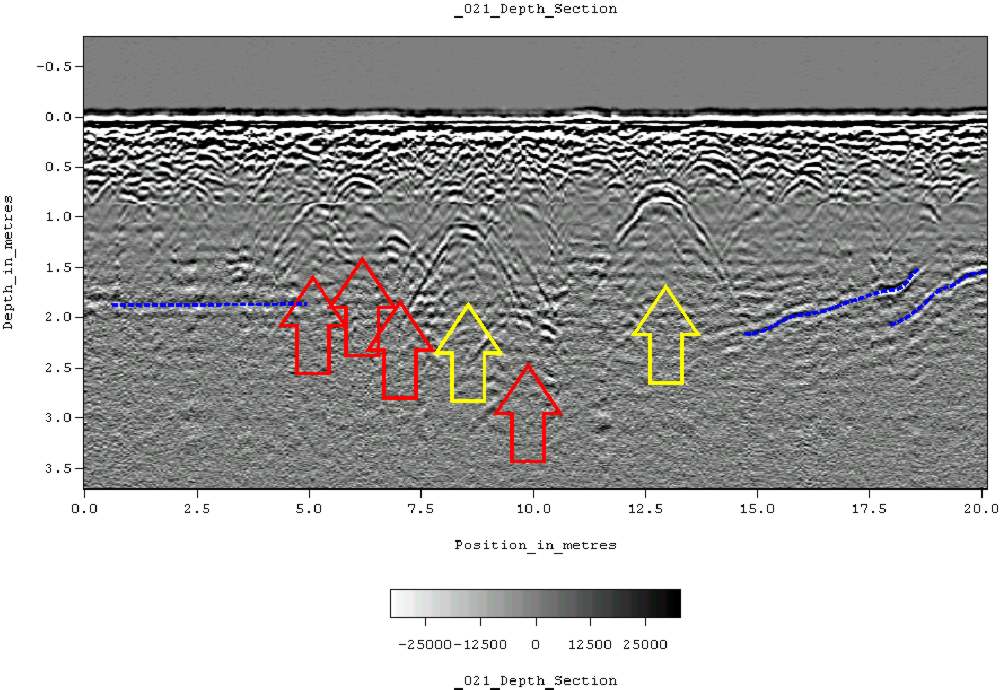
Following Reeves' announcement, Egypt's Ministry of Antiquities carried out a series of examinations to test the hidden chamber hypothesis. The first was an infrared thermography survey in mid-2015, which indeed detected a cooler spot on the north wall – consistent with a void behind it that might affect heat dissipation.
Japanese radar specialist Hirokatsu Watanabe conducted a GPR scan inside the tomb in late 2015. Watanabe's preliminary radar results were tantalizing: he claimed to have identified distinct voids behind both the north wall and the west wall, even describing "door lintel" features. However, skepticism remained among scientists because the data were not publicly released and radar imaging can be subjective in interpretation.
The Final Verdict: Comprehensive 2018 Survey
In early 2018, a multidisciplinary radar team led by Politecnico di Torino in Italy conducted an extensive series of GPR scans in KV62. This time, they acquired data at three frequencies (200, 400, 600 MHz) and systematically covered the burial chamber's north and west walls multiple times, collecting over 1.6 km of radar profiles for analysis.
After months of processing and cross-comparison, the conclusion was decisive: no hidden voids exist behind the walls, at least up to a depth of about 4–5 m. In May 2018, Dr. Franco Porcelli of Politecnico di Torino reported that the comprehensive radar survey showed no discontinuities indicating doorways or open spaces. Egypt's Ministry of Antiquities officially announced that the tomb does not contain any additional hidden rooms, bringing an anticlimactic end to the high hopes raised three years earlier.

This outcome – while disappointing to those longing for a new spectacular discovery – was an important reality-check demonstrating the need for rigorous, repeatable measurements. It also showcased how multiple independent scans and teams are essential to verify extraordinary claims. In science, a negative result can be just as valuable: we now know that Tutankhamun's tomb, unique as it is, was most probably not hiding another royal burial behind its walls.
Conclusions and Future Prospects
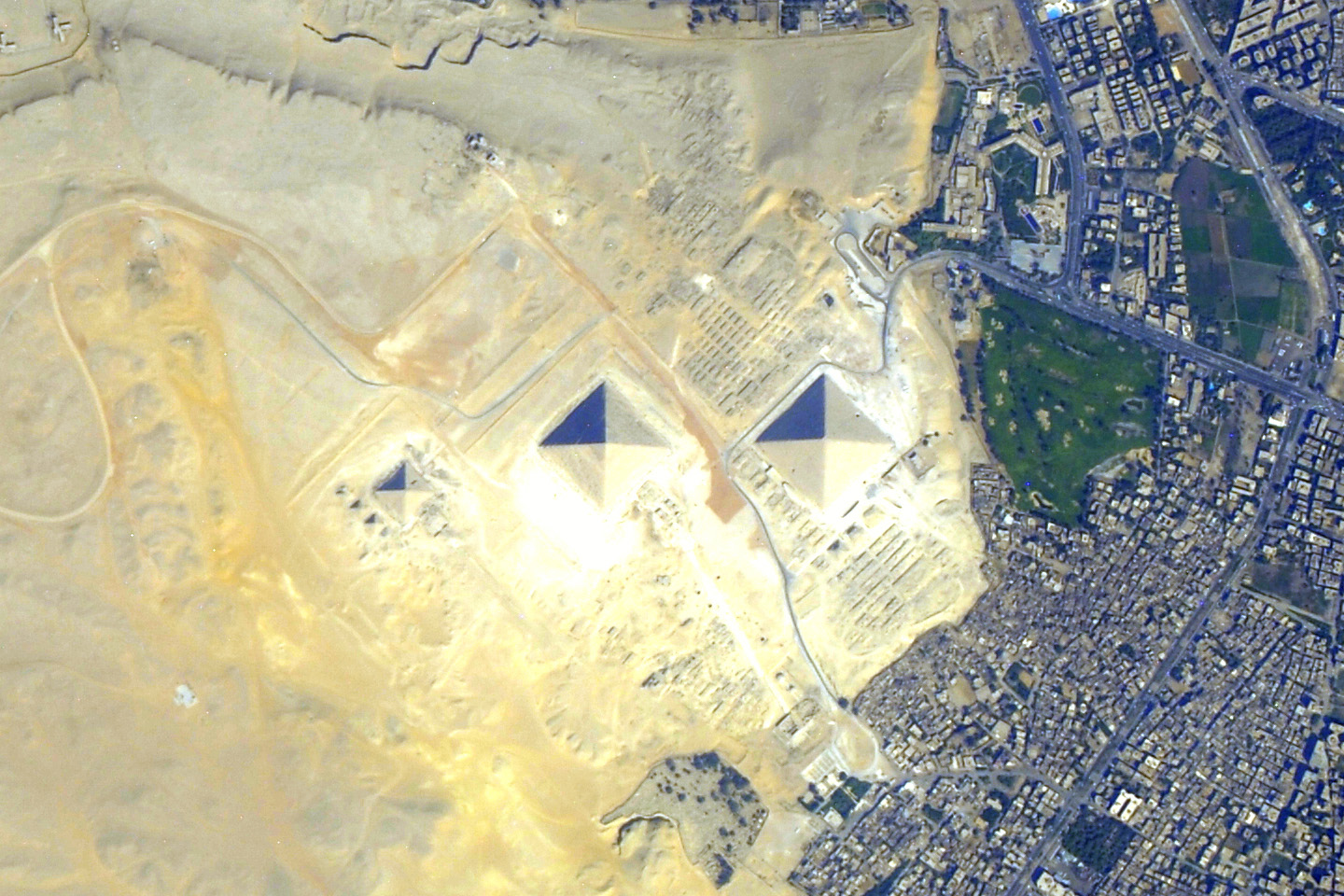
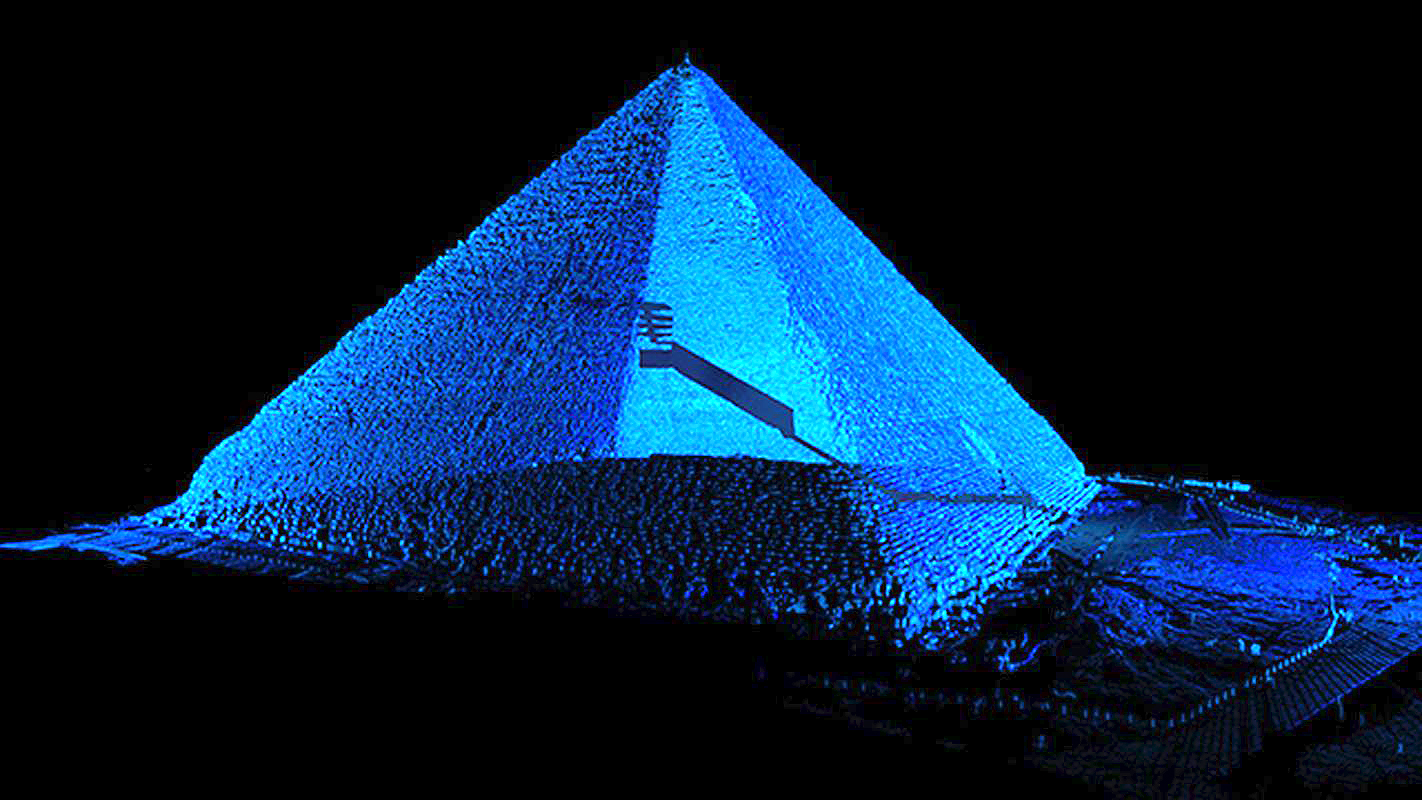
Recent projects like ScanPyramids and the Tutankhamun tomb scans demonstrate how interdisciplinary science is revolutionizing Egyptology. Muon radiography has emerged as a powerful tool to explore massive stone structures: it succeeded in revealing a void of unknown function in Khufu's Pyramid where traditional archaeology had no clues. That discovery has energized plans for even more sensitive muon telescopes to possibly map every cubic meter of the Great Pyramid's interior – perhaps finally answering questions about how these pyramids were built and whether any secret rooms remain.
At the same time, the radar scans in Tutankhamun's tomb, while yielding a negative result, were a critical scientific test of a hypothesis, reminding us that not every intriguing theory will be borne out by data. The ability to obtain a clear "no" in that case was as important for advancing knowledge as a "yes," since it lays to rest one of the biggest archaeological rumors of the decade.
Looking ahead, we can expect scanning technology to be applied to many other ancient structures in Egypt. ScanPyramids has also performed muon scans on the Bent Pyramid of Snefru, successfully imaging its known internal chambers and detecting subtle density anomalies that are still being analyzed. There is interest in using muography or microgravimetry to search for rumored voids under the Sphinx or in other pyramids.
As computational power and sensor resolution improve, these tools will only get better. A proposed project will place large muon detectors in the desert around the Great Pyramid to capture muons from all angles (a true tomographic scan), potentially resolving features as small as ~30 cm inside the pyramid's stone matrix. One can imagine a future where archaeologists routinely "scan" a site as a first step, much like a medical CT-scan, before deciding on any excavation.
Final Reflections
In summary, the marriage of archaeology and physics in Egypt has yielded both concrete discoveries – like Khufu's hidden chambers – and valuable null results – like the absence of chambers in Tutankhamun's tomb. Both outcomes enrich our understanding. We now know Khufu's Pyramid contains architectural features beyond the known rooms, hinting that the pyramid's design and construction were more complex than previously thought. And we know that Tutankhamun's modest tomb is likely just that – modest, without a hidden extension – suggesting he truly was buried in a small space due to his unexpected death, rather than having a grander hidden burial.
Each finding (or lack thereof) helps refine the stories we tell about these ancient monuments. The continued use of non-invasive scanning in Egyptology is not only minimizing harm to irreplaceable sites, but also maximizing the information we can gather – a win-win synergy of science and archaeology. As technology advances, who knows what lost secrets might yet be illuminated deep within the stone heart of a pyramid, or behind the walls of a pharaoh's tomb, waiting patiently for a curious muon or a radar pulse to betray their presence. Exciting times!
Figure Citations and Sources
Figure 1: Aerial photography of pyramids of Egypt. Source: Unsplash (Free use license)
URL: https://upload.wikimedia.org/wikipedia/commons/1/17/Great-Pyramids-of-Giza-Aerial-View-Cairo-Egypt.jpg
Figure 2: ScanPyramids project equipment and methodology. Source: CAEN - Tools for Discovery
URL: https://www.caen.it/news/scanpyramids-project/
Figure 3: Muon tomography diagram. Source: BBC Science Focus Magazine
URL: https://www.sciencefocus.com/future-technology/how-scientists-are-using-cosmic-radiation-to-peek-inside-the-pyramids
Figure 4: Advanced muon detection equipment. Source: CERN Courier
URL: https://cerncourier.com/a/cosmic-rays-for-cultural-heritage/
Figure 5: Great Pyramid cross-sectional diagram showing the Big Void. Source: Nature (Scientific Publication)
URL: https://www.nature.com/articles/nature24647
Figure 6: North Face Corridor characterization data. Source: Nature Communications (Scientific Publication)
URL: https://www.nature.com/articles/s41467-023-36351-0
Figure 7: Endoscopic view of the North Face Corridor. Source: Live Science
URL: https://www.livescience.com/cosmic-rays-reveal-hidden-30-foot-long-corridor-in-egypts-great-pyramid
Figure 8: Muon tomography process animation. Source: IEEE Spectrum
URL: https://spectrum.ieee.org/muon-imaging-finds-hidden-chamber-in-great-pyramid-of-giza
Figure 9: Luis W. Alvarez's 1969 pyramid experiment. Source: Nuit Blanche Blog (Historical Archive)
URL: https://nuit-blanche.blogspot.com/2012/10/sunday-morning-insight-muon-tomography.html
Figure 10: Ground-penetrating radar archaeological fieldwork. Source: ImpulseRadar GPR
URL: https://impulseradargpr.com/archaeology/
Figure 11: Tutankhamun's tomb layout plan. Source: Wikimedia Commons (Public Domain)
URL: https://commons.wikimedia.org/wiki/File:The_Tomb_of_Tutankhamun_according_to_Howard_Carter_-_en.svg
Figure 12: Ground-penetrating radar scan data. Source: Wikimedia Commons (Public Domain)
URL: https://en.wikipedia.org/wiki/Ground-penetrating_radar
Figure 13: Tutankhamun tomb artifact placement diagram. Source: Flickr (Historical Archive)
URL: https://www.flickr.com/photos/mharrsch/33049813133
Figure 14: Giza pyramids from International Space Station. Source: NASA Earth Observatory
URL: https://earthobservatory.nasa.gov/images/79253/pyramids-at-giza-egypt
Figure 15: Future archaeological scanning technology. Source: PBS Hawaii
URL: https://www.pbshawaii.org/time-scanners-egyptian-pyramids/
References and Further Reading
Note: This article draws from numerous scientific publications, news reports, and official announcements documenting these groundbreaking archaeological investigations. Key sources include papers published in Nature Communications, reports from the ScanPyramids project, Egypt's Ministry of Antiquities announcements, and coverage by leading science journalists and institutions worldwide. See the links above.
For the most current updates on these ongoing projects, readers are encouraged to follow the ScanPyramids project page and publications from the participating institutions, including HIP Institute, Cairo University, Nagoya University, and other international collaborators.
Audio clips (representational): Desert ambience (0:22), GPR sweep/pings (0:15), Endoscope servo/whirr (0:10), Muon “clicks” (0:15) — generated programmatically for this article; free to use, no attribution required.
This article includes the following interactive elements: click‑to‑expand images, inline audio snippets, and inline Wikipedia links for key terms that open in a new window.
Like to discuss or comment on this article? See my page on Facebook.